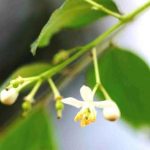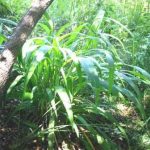TREE LIFE
January 1999
MASHONALAND CALENDAR
Saturday 2nd January: Mark’s first walk this month which actually replaces the December walk will be in the popular Mukuvisi Woodlands, and we expect a great variety of species to be up after the rains.
Tuesday 5th January: Botanic Garden Walk. Weather permitting our walk in the economic section continues and we will also have a look at more of the little known and seldom seen species on Mark’s list. We will meet Tom in the car park at 4.45 for 5 p.m. – there will be a guard for the cars.
Saturday 9th January: An invitation to join the Bonsai Society at their January meeting provides a wonderful opportunity to learn something about Bonsai from the fundis. Meet at John and Jo Hensman’s home – 9 Wood Lane, Borrowdale at 2.30 p.m. for the demonstrations and discussion. Tea at 4 p.m.; a Braai at 5 p.m. Please bring a plate of snacks for tea, a bottle of wine or your favourite drink and meat etc. for the braai, and of course a chair and eating utensils. The verandah and braai area is weatherproof, ice, charcoal or gas braais, music and safe parking provided.
Sunday 17th January: Norton area. Serui Source is beckoning once more. We discovered on our last trip, one year ago, that a single visit was just not enough, so Ann and James Sinclair have very kindly agreed on another visit.
Saturday 23rd January. Mark’s Botanic Walk, please phone Mark at home (745263) for the venue.
Tuesday 2nd February: Botanic Garden Walk.
February 5th to 9th. Reservations have been made at the Sabi River Safari Camp 12km from Birchenough Bridge on Mapari Ranch. A fully serviced kitchen with gas stove and paraffin deep freeze makes self-catering a pleasure. What to bring? All food, drinks and a torch. Cutlery, crockery, linen, etc. is provided. There is also a cook and a maid in attendance. Cost is $150 per person per night. Only a small group can be accommodated so if you are interested phone Maureen Silva-Jones at home to reserve your place or for more details.
MATABELELAND CALENDAR
Friday 1st January: Our New Year Social will probably be held at Jonathan Timberlake’s home. A little nearer the time please phone Jonathan at home to confirm details.
DICHWE LEMON FOREST, MHANGURA DISTRICT 18 OCTOBER 1998
Zimbabwe is a country so fortunate in it’s abundance of trees and insects and their great diversity.
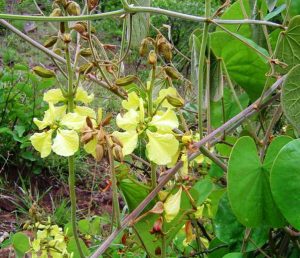
Tylosema fassoglensis. Photo: Bart Wursten. Source: Flora of Zimbabwe
Along the roadside were the beautiful yellow Bauhinia-like flowers of Tylosema fassoglensis, which were on the ground on long sprawling vine-like branches. The plant is in fact a tree and is known as a suffrutex or one of the underground trees of the Zambezi. The name refers to an under-shrub that produces leafy and flowering branches from an enormous underground rootstock. There are fourteen different suffrutex trees found in the Mukuvisi Woodlands according to Meg Coates Palgrave. The most spectacular is Leptactina benguelensis, which gives a circular white carpet of white waxy gardenia-like flowers. Seldom is it appreciated when standing on such a carpet one is on the top of a tree. These suffrutex trees are frequently found in wet marshy ground that is overgrazed and subject to frequent fires. It is thought to be an ecological adaptation to this environment. Another thought suggests that when the meteorite that hit the Earth in the region of Central America Sea it caused the demise of the dinosaurs and the suffrutex trees survived because they were underground and protected from the cold caused by the dust that would have blocked the sun’s rays. This would have occurred at the end of the Cretaceous Period when there was a mild climate with alternating seasons and the development of deciduous trees like fig, magnolia and poplar. Ficus verruculosa is one of the suffrutex trees found underfoot in the Mukuvisi Woodlands. The first winged insects had appeared in the Carboniferous period some 200 000 million years previously.
The area visited known as the Dichwe Lemon Forest is on Dichwe and Richmond Farms and is on the boundary of the Highbury Meteorite Crater. The meteorite was about 25 kilometres in diameter and hurtled to Earth at 20 kilometres a second. The impact was the force of 8000 times that of the bomb dropped on Hiroshima.
There is little evidence of the impact except for a river marking part of boundary of the crater. The uniqueness of the area is twofold. According to the useful handout given at the start of the outing, the Dichwe Lemon Forest is a rich riparian (riverbank) habitat that has probably survived in the present location for thousands of years. The forest area is about 40 hectares and occurs in a dolomite formation where the water table rises to the surface. The combination of rich soil and plentiful water has given rise to a forest unique to the Zimbabwean Highveld. The surrounding farmlands were dry and under irrigation and the soil reddish clay. The black soil was rich in organic matter and tins, socks and the odd boot were evidence of worm digging operations. A feature was a pool full of blue water lilies, Nymphaea that would have been the delight of the French impressionist, Claude Monet.
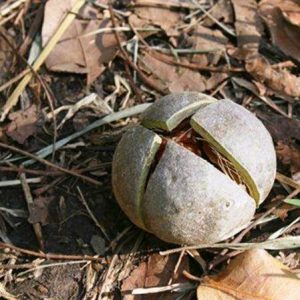
Khaya anthotheca. Photo: Mark Hyde. Source: Flora of Zimbabwe
When the sun came through the clouds the upper canopy was full of butterflies and birdlife, numerous thorny climbers, Acacia schweinfurthii and Pterolobium stellatum clung and clawed their way up giant trees. A Khaya anthotheca had been recorded at over 100 feet (33 metres) this is the same species as the “Big Tree” in Chirinda Forest. A first time find for some was the four-valved wooden capsule that houses the winged seeds.
Other trees previously recorded of giant stature were Acacia galpinii (130 feet or 40 metres), Acacia sieberiana (60 feet or 18 metres) and numerous Celtis africana (80 feet or 25 metres). In the more swampy ground was found Ficus sur in fruit.
Along the waterways were the usual Syzygium sp., Trichilia emetica, Ziziphus mucronata were on drier ground. An Erythrina latissima was doing a “Jack in the Bean Stalk” in an effort to get light and compete in the overhead canopy.
Away from where the water surfaced were thickets of Acacia schweinfurthii and the never to be forgotten Dichrostachys cinerea. It should be borne in mind that Dichrostachys is a hard wood with lethal thorn-like branches. One of these punctured the tyre of Andy MacNaughtan’s pickup. This was by no means the first such incident recorded.
Debate centered around as to why so many Khaya of the same large size had toppled over and were dead. It was thought that drought and fire may have weakened them and they had succumbed to a torrential wind and rainstorm. The soil is soft and would not have been much of anchor under such circumstances.
The second interesting feature of the area were the prevalent lemon trees which had been introduced to the area in the past by humans and were now seeding and propagating themselves in the rich wet soil under the trees, where they have become naturalised. Some were of magnificent proportions. The lemon is the Mazowe rough skin lemon Citrus limon and they formed a major constituent of the forests understorey. Rob Burrett thought the lemons were introduced in about 1640-1650 to prevent and cure scurvy. These trees formed the initial rootstock for the citrus plantations at Mazowe from the BSA Company at Piedmont Estates.
There is debate as to whether the Arabs, Indians or Portuguese, or even animals introduced the lemons. Close by there is an old settlement on one of the hills. The introduction of the lemons was human but other vectors may have been involved. The Arabs and Portuguese used the lemon for fevers. The Rauvolfia or wrongly named Quinine tree because of its bitter taste was used in the treatment of malaria, which is incorrect because it contains the drug reserpine which is used as a tranquilliser for the treatment of high blood pressure. Commercially the drug is obtained from Rauvolfia serpentina in India and Rauvolfia vomitoria from East Africa. Quinine is obtained from Cinchona bark (Cinchona officinalis).
So the lemon and the Rauvolfia are not the African equivalent of the colonial Gin and IT (Indian Tonic Water). Lemons are naturalised in riverine parts of Mozambique. Interesting is that in the Chimanimani forests granadillas have become naturalised and are harvested. Often when we have visited a riverine site and there is an old derelict homestead near at hand there are mulberries and guavas growing along the waterway.
A rare delight was to find a minute fig wasp from the Ficus sur. The diminutive creature sat on Andy’s finger blown by each breath of exhaled air. The insect was so small, only 2mm with an ovipositor equally as long. Her four wings transparent and reflecting the colours of the rainbow. The small black body glistened in the sunlight, and was probably her first experience of the sun and world outside the fig we had split open. It is an ancient alliance going back over aeons of time. The figs are 60 million years old and the wasp family Agaonidae much older.
Through the ages of evolution the two forms of life have become so interlinked that one cannot survive without the other and is a remarkable example of symbiosis. The relationship is complex having behavioural, morphological and ecological adaptations.
The fig does not have an exposed style, stigma and stamens for pollination. The fruit is an inverted receptacle containing numerous small petal-less and sepal-less flowers inside an urn shaped inflorescence called a syconium. It is derived from the Greek word for fig, which is sukon.
The female wasp is attracted to the syconium by smell and forces her way through the tiny opening at the front of the fig fruit called an ostiole. It is a tight squeeze and wings, plus antennae are lost in the process. These appendages are redundant inside the confined interior of the fig. Her pollen sacs on her legs are not harmed and the pollen is carefully carried by the little wasp that deliberately pollinated the fig flowers. The female lays her egg into flowers that do not have a long style and seed. These flowers have a short canal into which her ovipositor fits. These flowers form galls for feeding the larvae of the wasp. A remarkable example of symbiosis because the tree has flowers for seed production and flowers for the eggs of the wasp.
Each egg hatches into a larva that pupates. The first adults to emerge are the wingless, blind, almost legless vermiform males. The males identify the pupae containing female wasps and open them and impregnate the captive females before they emerge. The second function is for the males to bore a hole through the syconium wall, which allows in air containing oxygen into the fig. The females are stimulated and collect pollen from the male flowers and store this in their pollen sacs. They leave through the tunnels made by the males, in search of a fig tree of the same species with a syconium waiting to be pollinated. The oxygen in combination with ethylene formed by the fig makes ethylene oxide, a ripening agent. The fig ripens about five days after the pollinators have flown away. The ripening is a unique feature and relies upon the puncturing of the fig wall. The prophet Amos was a nogedim or sheep raiser (Amos 1:1) and a dresser of sycamore trees (Amos 7:14). Some translators may not have understood the purpose of fig pricking or nipping to get them to ripen.
The specific pollinator of the common wild fig, Ficus thonningii is the wasp Elisabethiella stuckenbergi. The wasp for Ficus sur had a much longer ovipositor and the openings to the sterile ovule probably have a longer neck. A local authority on fig wasps is Father Watcham and he has illustrated them. The best-known economic example is the Smyrna fig, which has no pollen and must be pollinated by the Capri fig. The Capri fig insect, Blastophaga psenes was introduced to California in 1899 from the Middle East to pollinate the Smyrna fig. The Capri fig is inedible. In 1908 the little wasp was brought to South Africa for the Capri Figs in the Cape and given free of charge for years to the growers of Smyrna Figs. This was discontinued because the fig was not found to be an economic proposition.
The association between the little fig wasp and the fig tree is an amazing alliance going back through the ages. Somehow at Dichwe there were reminders to the past whether geological or by symbiosis and there is a feeling of privilege to have set foot there and wondered about so many different aspects of that environment.
-MARY TOET.
MASEMBURA Sunday 15th November 1998.
Bear with me Guys! “THOSE TWO”, have taken shameful advantage of a raw new unsuspecting member!
Following a well-worn path from the dam wall down to the Pote River where the group of increasingly hot members (about 35°C – WHEW!), wound their way along the attractive granite-strewn river, viewing a good variety of species. Along the bank, we saw the river Rhus, Rhus quartiniana, Salix subserrata (used for cricket bats and bagpipes) and of course the ubiquitous Waterberry, Syzygium guineense. Other species and their families were:
ANNONACEAE – Annona senegalensis (indigenous edible custard apple), the leaves having a distinct smell when crushed.
CAESALPINIOIDEAE – Brachystegia boehmii, (Mfuti or Prince of Wales feathers, with gorgeous pink feathery fronds unfurling from fat red yellow buds to full flowering trees; Cassia abbreviata, with yummy yellow scrambled egg flowers.
COMBRETACEAE – Terminalia mollis and Terminalia stenostachya and what was thought to be Combretum collinum.
DIPTEROCARPACEAE – Monotes glaber, this one is hairless i.e. glabrous.
EBENACEAE – Diospyros lycioides.
EUPHORBIACEAE – Pseudolachnostylis maprouneifolia (Duiker berry).
LOGANIACE – Nuxia oppositifolia, in flower.
MALVACEAE – Azanza garckeana (Snot apple).
MIMOSOIDEAE – Dichrostachys cinerea – Long single spines and in flower with its lovely little pink and yellow lanterns; Acacia goetzei, tiny hooks on back of leaves; Albizia antunesiana, pretty uniform leaves, slightly hairy undersides.
OCHNACEAE – Ochna puberula. A comment from Phil – a good South African or Scottish tree – the OCH is what does it!!
PAPILIONOIDEAE – Dalbergia melanoxylon, sweet scented and in flower; Swartzia madagascariensis (the lovely Snake bean in flower and delicately perfumed).
POLYGALACEAE – Securidaca longipedunculata, (Wild violet tree, heavenly scented purple pea flowers but used in traditional medicine to induce abortion).
RUBIACEAE – Catunaregam spinosa (Kim Damstra’s memory jogger “Cat in your rectum!”).
SAPINDACEAE – Dodonaea angustifolia (Sand olive).
SUGGESTION: How about a Photo/Slide Library of our beautiful indigenous trees in flower, seedpods if possible, leaves and bark, also an Atlas of area we visit – to help Greenhorns like me?
SMACK-SMACK, Andy for sending half the group back to town “through a nice forested area”? !! – Chinamora Reserve and down the Domboshawa road on a Sunday night Ughh!
HAPPY XMAS EVERYONE,
-I.D.
WELSTON RD: 29th NOVEMBER 1998
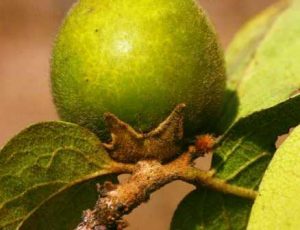
Diospyros kirkii. Photo: Mark Hyde. Source: Flora of Zimbabwe
On Saturday, November 29th 1998, a group of c.12 gathered at 12, Welston Rd, by courtesy of Sue Garnett and John and Sue Holloway. Their land is a fine piece of undeveloped woodland, set in hilly country, just north of Harare.
After the recent rains, all was fresh and green with the herbaceous flora having appeared extremely rapidly. The first part of the walk contained few surprises with trees such as Acacia amythethophylla and Acacia polyacantha, spring herbs such as Dolichos kilimandscharicus, Thunbergia lancifolia and Chlorophytum, spp. and a brownish orchid with a prominent white lip, Eulophia venulosa. Perhaps the most interesting tree was Diospyros kirkii; I was not aware of it so close to Harare, but Maureen mentioned that it also occurs at Christon Bank, which is not very far away as the crow flies.
Much more of interest was seen as we descended into a steep valley containing the Thinyika (or Chinyika) River. On the steep slope, into which steps had been cut, was a beautiful flowering Xerophyta (? Xerophyta equisetoides) and the red spherical heads of Scadoxus multiflorus.
John told us that the stream flows throughout the year and, like many such habitats near Harare, it has been colonised by weedy introductions, which find it difficult to survive our long dry season, but are fine given some water. The Greystone Park Nature Reserve is another area full of exotics.
For example, there were enormous rosettes and greenish erect spikes of Plantago major (the Rats-tail Plantain of Europe), Galinsoga parviflora (Gallant Solider), masses of Rorippa nasturtium-aquaticum (Watercress – presumably introduced), Duranta repens, Toona ciliata (Cedrella), Ageratina adenophora, Verbena bonariensis and a pink Evening Primrose (Oenothera rosea). Also present was the climbing passionflower (Passiflora subpeltata) in both flower and fruit and the ubiquitous Mondia whitei.
The native flora was also of interest. There were frequent pinkish-white flowers of the shrub Acokanthera oppositifolia and in the deep shade were some trees of Ilex mitis and Myrica serrata. A very fine specimen of the yellow and brown-flowered orchid Eulophia streptopetala was also seen.
An interesting spot close to town, which would probably be worth revisiting at a different time of year.
-Mark Hyde
CHRISTMAS SOCIAL AT VAL D’OR; DECEMBER 6th 1998
By kind permission of Bill Clarke, the Tree Society’s annual Christmas get-together was held at Val D’Or, Bill’s weekend cottage, between Arcturus and Ruwa. The Society first visited Val D’Or on my Saturday afternoon walk in September and even at that time, in the rather leafless and brown dry season, there was much of interest, both in the woodland and in the stream system near to the house.
Now, in the rainy season, with fresh green growth everywhere – green grass and green trees, there was even more to be seen.
About 26 people attended and we assembled first of all by tables in the garden near to the bar, where we had tea and tucked into the various plates of snacks that members had provided.
The main event of the morning was the Tree Bingo. Always deservedly popular, it keeps people concentrating on what is seen and prevents a “disinterested tail” forming. Phil Haxen led the party, keeping up a constant flow of tree names and information. Despite stern warnings about bribery, in fact Phil proved quite amenable to suggestions as to which tree should be looked at next.
A number of interesting species were seen. Both the Sausage Tree (Kigelia africana) and the Pod Mahogany (Afzelia quanzensis) were present at rather high altitudes (1520 m) for those species, although it is of course possible that they were planted, as for example (Acacia) Faidherbia albida and Acacia xanthophloea, both of which occur at much lower altitudes in the wild, certainly had been. Indeed, one of the great problems of the day for me was disentangling what is native from what is introduced.
Amongst some rocky woodland we saw a species of Monadenium, presumably Monadenium lugardiae. This resembles a green slender pineapple with an apical tuft of soft green leaves and producing copious milk when picked.
Just as we were heading back towards the house, Dagmar Lawrence shouted out “Bingo” (or was it Bequaertiodendron magalismontanum?) and shortly after, Kenneth Haxen (cries of nepotism!) came in second. Both won bottles of wine, which particularly pleased Kenneth. On the way back to the house, we stopped at the bottom of a wooden tower that a number of members climbed to admire the view.
Nearby was a specimen of Abrus precatorius. This is a climbing or (in this case) creeping species, a legume, with pinnate leaves, which produces striking red and black seeds, somewhat similar to lucky-beans. I have never seen this before at this altitude, which is most interesting – again, could it have been planted?
Back in the garden, Andy presented the prizes and gifts and there then followed a relaxed and pleasant lunch. Afterwards, we walked along the dam wall to search for the small herb Drymaria cordata that we found on our previous visit. It was found quite easily, although only leaves and no flowers were seen.
In the forest below the dam, some exotics were competing vigorously with the native vegetation. A spectacular one was a creamy-yellow flowered climber that was festooning the trees. It is Pithecoctenium crucigerum, a species from the Bignoniaceae, commonly planted in gardens. Another species doing the same was a spectacular species of Ipomoea, all of which are of garden origin, at least in central Zimbabwe.
We then walked down the river and the party became somewhat separated. The group I was with spent some time examining Coucals on one of the dams and I found a small pit amongst rocks which looked like an abandoned garden.
All in all, a pleasant and relaxing day amongst friends, enjoying the hospitality of Bill and Fiona. Our thanks go to Maureen for all her hard work in producing the bingo cards and to Andy for organising the signs, prizes and chocolates.
-Mark Hyde
ANDY MACNAUGHTAN CHAIRMAN


